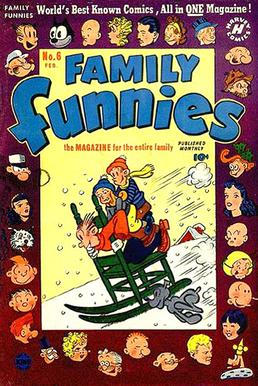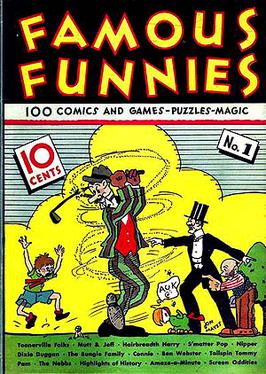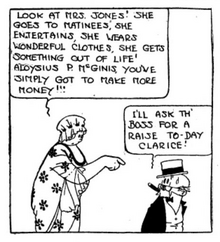"Keeping up with the Joneses" is an idiom in many parts of the English-speaking world referring to the comparison of oneself to one's neighbor, where the neighbor serves as a benchmark for social class or the accumulation of material goods. Failure to "keep up with the Joneses" is perceived as a demonstration of socio-economic or cultural inferiority. The phrase was coined by a 1910s comic strip of the same name.

Barney Google and Snuffy Smith, originally Take Barney Google, for Instance, is an American comic strip created by cartoonist Billy DeBeck. Since its debut on June 17, 1919, the strip has gained a large international readership, appearing in 900 newspapers in 21 countries. The initial appeal of the strip led to its adaptation to film, animation, popular song, and television. It added several terms and phrases to the English language and inspired the 1923 hit tune "Barney Google " with lyrics by Billy Rose, as well as the 1923 record "Come On, Spark Plug!"

William Morgan DeBeck, better known as Billy DeBeck, was an American cartoonist. He is most famous as the creator of the comic strip Barney Google, later retitled Barney Google and Snuffy Smith. The strip was especially popular in the 1920s and 1930s, and featured a number of well-known characters, including the title character, Bunky, Snuffy Smith, and Spark Plug the race horse. Spark Plug was a merchandising phenomenon, and has been called the Snoopy of the 1920s.
Don Markstein's Toonopedia is an online encyclopedia of print cartoons, comic strips and animation, initiated February 13, 2001. Donald D. Markstein, the sole writer and editor of Toonopedia, termed it "the world's first hypertext encyclopedia of toons" and stated, "The basic idea is to cover the entire spectrum of American cartoonery."

A topper in comic strip parlance is a small secondary strip seen along with a larger Sunday strip. In the 1920s and 1930s, leading cartoonists were given full pages in the Sunday comics sections, allowing them to add smaller strips and single-panel cartoons to their page.
United Feature Syndicate, Inc. (UFS) is a large American editorial column and comic strip newspaper syndication service based in the United States and established in 1919. Originally part of E. W. Scripps Company, it was part of United Media from 1978 to 2011, and is now a division of Andrews McMeel Syndication. United Features has syndicated many notable comic strips, including Peanuts, Garfield, Li'l Abner, Dilbert, Monty, Nancy, Over the Hedge, and Marmaduke.
Donald Duck, a cartoon character created by the Walt Disney Company, is today the star of dozens of comic-book and comic-strip stories published each month around the world. In many European countries, Donald is considered the lead character in Disney comics, more important and beloved than Mickey Mouse.

Apartment 3-G is an American newspaper soap opera comic strip about a trio of career women who share an apartment in Manhattan. Created by Nicholas P. Dallis with art by Alex Kotzky, the strip began May 8, 1961, initially distributed by the Publishers Syndicate, which later merged with King Features Syndicate in 1988.

Milt Gross was an American cartoonist and animator. His work is noted for its exaggerated cartoon style and Yiddish-inflected English dialogue. He originated the non-sequitur "Banana Oil!" as a phrase deflating pomposity and posing. His character Count Screwloose's admonition, "Iggy, keep an eye on me!", became a national catchphrase. The National Cartoonists Society fund to aid indigent cartoonists and their families, for many years was known as the Milt Gross Fund. In 2005, it was absorbed by the Society's Foundation, which continues the charitable work of the Fund.

Toots and Casper is a family comic strip by Jimmy Murphy, distributed to newspapers for 38 years by King Features Syndicate, from December 17, 1918 to December 30, 1956. The strip spawned many merchandising tie-ins, including books, dolls, paper dolls, pins, bisque nodders and comic books.

The Bungle Family is an American gag-a-day comic strip, created by Harry J. Tuthill, that first appeared in 1918. Originally titled Home, Sweet Home, it first appeared as part of a series of rotating strips in the New York Evening Mail. The strip ran until June 2, 1945.

Famous Funnies is an American comic strip anthology series published from 1934 to 1955 with two precursor one-shots appearing in 1933–1934. Published by Eastern Color Printing, Famous Funnies is considered by popular culture historians as the first true American comic book, following seminal precursors.
This is a timeline of significant events in comics in the 1910s.

Kenneth Frederick Ernst was a US comic book and comic strip artist. He is most notable for his work on the popular and long-running comic strip Mary Worth from 1942 to 1985. With his realistic style, uncommon in those early years, Ernst paved the way for soap opera strips that followed.

Right Around Home was a comic strip by Dudley Fisher that was distributed by King Features Syndicate from January 16, 1938 to May 2, 1965.
The Bell Syndicate, launched in 1916 by editor-publisher John Neville Wheeler, was an American syndicate that distributed columns, fiction, feature articles and comic strips to newspapers for decades. It was located in New York City at 247 West 43rd Street and later at 229 West 43rd Street. It also reprinted comic strips in book form.
Quincy is an American syndicated newspaper comic strip published from July 13, 1970 to October 4, 1986, created and produced by cartoonist Ted Shearer. The series, about an African-American boy being raised by his grandmother in Harlem, was one of the earliest mainstream comic strips to star an African American in the lead role, following Dateline: Danger! (1968-1974) and Luther (1969-1986). Another predecessor, Wee Pals, features an African-American among an ensemble cast of different races and ethnicities.
"Keeping up with the Joneses" is an English idiom for trying to match the lifestyle of one's neighbors.
Associated Newspapers, Inc. was a print syndication service of columns and comic strips that was in operation from 1912 to c. 1966. The syndicate was originally a cooperative of four newspapers: The New York Globe, the Chicago Daily News, The Boston Globe, and the Philadelphia Bulletin. Associated Newspapers was led by Henry Herbert McClure (1874-1938), a cousin of S. S. McClure, founder of the McClure Syndicate, the first American newspaper syndicate. In 1930, Associated Newspapers was acquired by and became a subsidiary of the Bell Syndicate. The syndicate's most successful, long-running strip was Gladys Parker's Mopsy.

Arthur Ragland "Pop" Momand was an American cartoonist best known for his comic strip Keeping Up with the Joneses.











